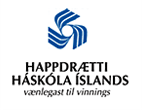Email: visindavefur[at]hi.is Tel.: +354 525 4765
Editor in chief:
Jon Gunnar Thorsteinsson, M.A. in English literature (jongth[at]hi.is)
Project managers:
Emilia Dagny Sveinbjornsdottir, geographer (emilia[at]hi.is)
Emelia Eiriksdottir, chemist (emelia[at]hi.is)
Ivar Dadi Thorvaldsson, student (ivardadi[at]hi.is)
The Icelandic Web of Science was originally a project started when the
city of Reykjavik was appointed one of several "cities of culture" of Europe in the year 2000. It was to be a sixmonth trial project, aimed at raising social awareness of science among the general public by allowing people to ask for knowledge as the questions arise in their daily life. The sixmonth trial period was soon extended since interest and excitement about scientific knowledge in this form, particularly amongst young people, far exceeded the initial expectations.One of Iceland's most popular websites
The Icelandic Web of Science is among the top 15-20 most popular
websites in Iceland. Weekly traffic amounts to 18.500 individual users, or roughly 6% of the population of Iceland. Put in context this means that a similar website in Belgium would receive more than 635.000 guests every week, a website in England three million guests and a website in Germany nearly five million guests. The Icelandic Web of Science receives on average 30 questions per day. Published answers on our website are 7.200 (June 2008).The questions and the inquirers
In the reception of questions we follow a simple and positive
policy. No questions are refused or directly bypassed as long as they concern science and are sincere and serious. If needed, we amend spelling and presentation of the questions so as to protect the interests of the inquirer. In this way we seem to have managed to build up an atmosphere of reciprocal trust between the website and the public. Since we collect data on individuals asking questions we have a clear picture of the querying group. It seems to be quite broad in all respects, but the proportion of young people, between 10 and 20 years of age, is, relatively high and hence this group is in focus, thus helping to increase science awareness and excitement among the young generation.The broad scope
Already in the beginning it was decided that the Science Web of the
University of Iceland would cover all scientific or scholarly subjects, from the universe to the soul and from medicine to philosophy. This seems to have been a wise decision. Among other things it means that the visitor does not have to hesitate to think about the discipline to which his or her question will belong to. This has also helped to create a solidary support for the website within the community of the University.Editing policy
Our editing policy is also clear and simple. The answers should be
written in a language suitable for the general reader, preferably according to the educational level and age of the inquirer. The length of each answer should in general be between half a page and a couple of pages, such that it contains a "complete thought" as opposed to simple fact, and still is not too long for the general reader. From the very beginning an eye was kept on the whole of the product that was being accumulated. Thus, the style of the answers should indicate that they are reliable and written by knowledgeable persons. Today more than 700 authors have added material to the encyclopedia; the majority of them are associated with the University of Iceland. Sources and references are given when appropriate, although preferably without disturbing the flow of the text. We also try to finalize spelling, grammar and presentation to a level similar to that of a printed book. In 2003 we published a book, where 200 of our most popular answers were selected.We have had weekly columns in three of Iceland's newspapers dedicated
to our latest answers. The material which has accumulated in the web's database is now equivalent to some 6500 pages of printed text or 12 large volumes. However, modern web and database technology makes the material in many ways much more useful than traditional printed encyclopedias. With a single click the reader of a given answer can browse through several related answers, explicitly shown in the text's body. At the end of every answer he or she will also find a short list of related subject items. By clicking on one of these, all related questions will appear in a list, so the reader can easily continue his reading on the subject. The sheer quantity and diversity of the material has gradually increased the probability that we already have an answer to a given question submitted today. We have experienced this when we invite classes of pupils to send questions to us for (almost) realtime answers. This has turned out to be easy for us, since we now have the strong foundation of the database to work with.Our answers in English are focused on material that relates to Iceland
and of interest to foreign readers. This includes for example Icelandic nature, history or literature but we will not totally exclude other things. By this we hope gradually to establish a contact with interested visitors from all over the world.Creating a dialogue
The Icelandic Web of Science tries to create an environment where the
public at large, especially young people, become enthusiastic about scientific knowledge on their own premises. By encouraging a dialogue between the scientific community and society at large, where science matters to the individual, both policymakers and citizens are able to make better informed choices from the range of options presented by technological progress in modern society.For further information on the Icelandic Web of Science please
contact: visindavefur[at]hi.is


